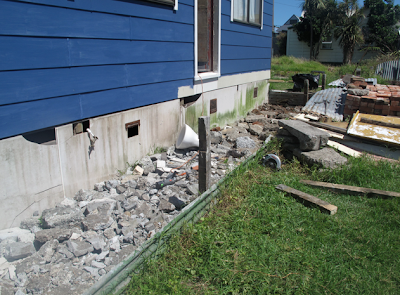ETR for the Wanganui Chronicle, 25-08-12
As I have written in the last three columns, ecological
design is holistic. It considers the relationships between elements of a system
as important as the elements themselves. Ecological design is all about making
connections in our minds based on the interrelationships we observe in the
world around us.
In writing, one form of connection is the segue – a literary
link. I’ll use the one concept included in the last three columns – multiple
functions – to segue onto the last of the design principles we followed during
this project: the ‘Three R’s’ reduce, reuse, and recycle.
Where ‘reduce’ is more of an umbrella concept including the
reduction of material and energy waste, ‘reuse’ and ‘recycle’ are strategies we
can put in place to achieve the reduction of waste and the conservation of
resources. In other words, by reusing and recycling, we reduce what goes to
landfill, and we reduce the amount of new materials that need to be extracted
and manufactured. These are good for both the planet (eco) and the wallet
(thrifty).
During the renovation we diverted over 95% of all materials
from landfill, and spent a total of less than $50 on rubbish fees. On the other
hand, we made over $300 recycling scrap metal, and have a big pile of
untreated, unpainted ‘scrap wood’ ready for the wood burner. (See Urban Chainsaw post.)
Some framing timber and lots of sarking was too filled with
borer to reuse in any other form than feeding the Shacklock. Other native
hardwoods that came out of the renovation were ideal for reuse where the building
code did not require that certain timber be used. One example is the former
deck (aka trampoline) that became an attractive fence that serves multiple
functions.
Those functions include: privacy screen; dog-excluder; wind
barrier, trellis, and teaching tool. Yes, much can be learned from pulling and
straightening nails as our interns John and Amy discovered.
The most important
lesson is the most abstract: mindfulness. Mindfulness 3 R style can be
described as materialism, but not the Madonna kind. A materialist recognizes
the value and potential of objects. This should not be confused with being
materialistic, or addicted to consumerism.
I would suggest that materialists do well at the 3 Rs, and
are more likely to frequent op shops, building salvage centres, and auctions.
In the case of the latter two, quality products always fetch fair prices, while
junky products are nearly always worthless. In other words, in appears that
high quality goods are more expensive to purchase new but hold their value
longer, but low quality products do not hold what little value they had to
begin with.
This brings me back to the former-deck-turned-fence.
Although the timber had been exposed to coastal elements for 30 years, most of
the individual boards were still sound. Although we could possibly have reused
them to build another deck, we preferred to build a brick patio that would
serve as a heat sink for subtropical plantings such as banana, Tahitian lime
and tamarillo. With the brick patio in place, the deck-turned-fence became a
windbreak for the banana and Tahitian lime, both of which came through June
frosts fairly well.
Before the brick patio and fence
After: Brick patio and fence on a frosty morning.
In the end, John and Amy learned some things about creative
reuse, about construction and about permaculture design. We now have some attractive
fences that keep dogs away from our chooks and ducks, block the wind, and allow
us to run around naked in our back section. Wait a minute, did I just say that?










I was trying to take an artsy picture of the fire hydrant but noticed the fence behind...
ReplyDeleteyard fencing